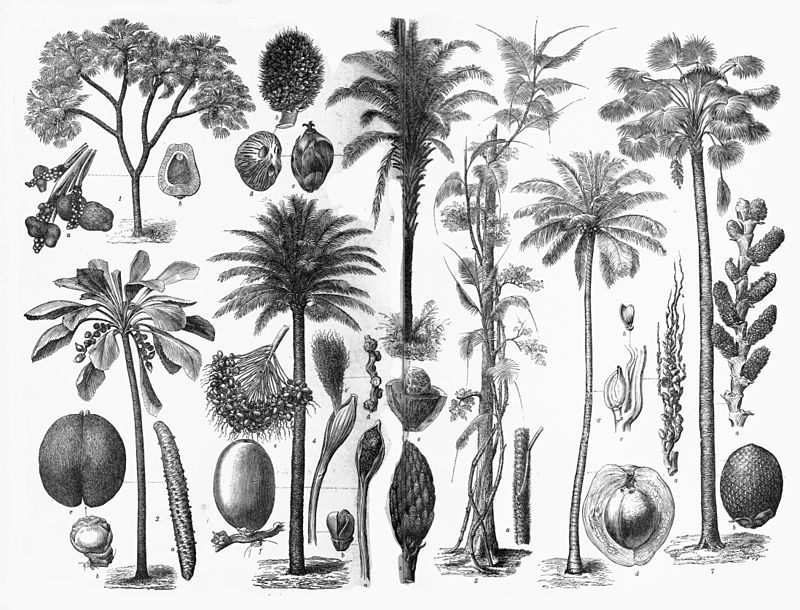The Irrepressible Palm Tree Tourists Who Travel the World to See Fronds
Just looking for a little bit of paradise.

Palms in Argentina. (Photo: Public Domain)
Grant Stephenson can rattle off facts about palm trees in the way others chatter about baseball: Did you know palm trees have the largest seed of any plant? Did you know Raffia palms have the longest leaves in the plant kingdom at up to 80 feet long? That there are palms so hard you can throw a spark off them with a machete? Petrified palm wood is the official state stone of Texas and the state fossil of Louisiana. Latin names like Clamus, Ceroxylon, and Lodoicea roll off his tongue like a starting lineup.
“I can talk six or eight hours and still not tell you everything you need to know about trees,” says Stephenson, who speaks with an amiable drawl and runs Horticultural Consultants, Inc. in Marble Falls, Texas, procuring and selling palms and other tropical plants, and advising people on how to care for them.
Stephenson’s business is palms, but they are also his life. He spends several months a year scouring the earth for them. He estimates he has seen close to 2,000 palm species on over more than 50 expeditions. And on many of these trips he’s not alone—he is joined by hundreds of like-minded fans for whom the tree that has become synonymous with chilling out is much more than a nice landscape feature.

Different species of Arecaceae. (Photo: Public Domain)
Stephenson sits on the board of directors of the International Palm Society, of which he is also a card-carrying lifetime member. Founded in 1956 in Florida, the organization metes out grants for palm research, publishes a journal (Palms), maintains a well-used message board, “Palm Talk” (where “pics please” always means “pictures of palms, and more of them”), and offers trips around the world for hundreds of palm-obsessives, which Stephenson helps organize. Up to 200 people from all over the world attend biennial treks to places like Australia, Thailand and Venezuela in order to mingle with trees all day, then listen to experts talk about trees in the evening. This year’s trip to Borneo is sold out, and promises voyagers the opportunity to see up to 80 different kinds of palms.
“I’ve literally rid trains over the River Kwai, speedboats down it and elephants through it,” says Stephenson, laughing. In photos on his website, Stephenson looks a bit like Indiana Jones meets the Dude—tan with chin-length hair, a brimmed hat and neckerchief. And scaling a palm tree.

Palm trees in the desert: Andreas Canyon in Palm Springs. (Photo: Nina B/shutterstock.com)
Palms have long exerted a mystical pull over travelers. The poets John Milton and William Cullen Bryant name-check them in verse; Alfred Tennyson called them “knots of Paradise”. Modern day wordsmith Channing Tatum told fans in a Reddit AMA that he would like a “magical palm tree that had a lot of shade with instead of coconuts there’s just peanut butter jelly sandwiches with cheetos underneath”.
On PalmTalk, biennial trekkers swap photos, stories and memories, fondly recalling the thrill of seeing palms in their natural habitat, where they photograph them, touch them and sometimes even talk to them. Wrote one traveler, “No matter where people are from, no matter what they do for a living, no matter what other interests or philosophies they may have, for one week everyone has one thing in common: PALMS.”
IPS travelers have hauled themselves by rope up steep hillsides in Thailand to clap eyes on the rare Maxburretia, traveled by donkey, helicopter and hanging bridge, steered dug-out canoes through Madagascar and floated down the Amazon. Once, in Chiang Mai, Thailand, Stephenson handed out leech-proof socks to 200 explorers. They turned out to be only moderately helpful.
“I got an award for having the most leeches with 26,” he says.

Palms at Le Jardin Majorelle in Marrakech. (Photo: Miguel Discart/CC BY-SA 2.0)
What is it about palms that makes plucking a few dozen bloodsucking worms from your body a reasonable obstacle to brave? Stephenson has no shortage of reasons. You can build with them, eat them and make wine from their sap. Seashore palms hold sand dunes together, and palms are remarkably good at taking care of themselves, transforming their own foliage into compost. The Guihaia palm (also known as “The Dainty Lady”) has silvery leaves that look beautiful reflected in water. But beyond their practical and aesthetic appeal, Stephenson says palm trees exert a kind of psychic pull over people.
“There’s something about the sound of the wind blowing through different types of palms that’s very calming, very soothing,” he says.

A forest of palms in Mauritius. (Photo: Miwok/Public Domain)
Hospitals plant palm trees to detract from the somber environment and casinos install them to loosen people up, says Stephenson. Palms just make people happy.
It is difficult to prove this theory broadly, but if Stephenson is any indication, there might something to it.
Stephenson is on the road a lot, which makes it hard for him to answer pesky reporters with speed. In an email, he apologized for not responding right away. He ended his short note with a sentiment not typically doled out to near strangers, kind of the email equivalent of wind through palm fronds.
“Have a great day, week, month, year,” he wrote. “What the hell, have a great life.”














Follow us on Twitter to get the latest on the world's hidden wonders.
Like us on Facebook to get the latest on the world's hidden wonders.
Follow us on Twitter Like us on Facebook